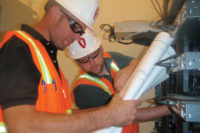
During these early years, when a sale stumbled across my path I would quickly attempt a calculation of what the costs might be, then come up with something to add to it that might help me pay my bills. Much of the time I was not very successful at this method, as there were many occurrences of bills left over at the end of the money.
Through many trials, painful errors, and ever-closer study of true costs, I became better at predicting expenses and at judging the premium that I might add to pay myself and still get the job. Through those early years and even today, I wrestle with a question: Exactly what is the appropriate profit that any given job should yield?
And a very important question it is. Pricing policy dwells at the center of virtually every transaction, and clear and consistent operating guidelines are at the center of business success. Without a consistent policy, your sales force will spend an equal amount of energy negotiating selling prices with your company as with your customers.
At one end of the equation the answer is easy: Charge what the market will bear and bank the highest profit possible. It is the other end of the same equation that is troublesome: What is the minimum amount of profit that would be acceptable in order to undertake a given job? After all, without an appropriate return on energy expended on any commercial enterprise, all that has been accomplished is wear and tear on your tools.
As it became clearer to me, through sophisticated segment analysis and job-costing exercises, exactly what the costs in association with each job were, I began to think of the profits associated with that job as a return on investment. This realization, as basic as it might sound, was a revelation to me. In this frame of mind I was able to craft a logical pricing formula based on sound principles.
In the financial world, the expected returns on any given investment are greatly influenced by an assessment of the associated risk. A common basis for a "no-risk" investment is U.S. Government debt. All other investments have differing degrees of higher risk; therefore, in order to attract investment these investments need to provide a higher anticipated return. Considering the relative risk of any investment, the return increases as the risk increases.
For example, if 10-year U.S. Government treasury bonds (generally today's zero-risk standard) are yielding 6 percent, then corporate bonds issued by the highest-rated companies might yield between 6.5 and 8 percent. Climbing the risk ladder, bonds issued by companies with lower ratings (and a greater risk of default) will continue up the yield curve. Stocks, whose values increase or decrease based upon their future earnings (which are hard to predict with any assurance of complete accuracy) are expected to yield higher rates of return.
Again, the greater the risk, the greater the potential return, with some high-risk, high-growth stocks yielding in excess of 20 percent.
These principles of investing play a great part in the pricing equation of your business. At a time when government bonds are yielding 6 percent, why would anyone undertake a business proposition in which the total yield was expected to be this low? If this was all you would end up with at the end of the day, you would be better off investing the money in treasuries and going to the beach.

Setting Minimum Profit Levels
Where does your business fit within the realm of risk described in the preceding examples? More specifically, what is the appropriate return for undertaking electronic security installations?The standard, more predictable investments previously mentioned can be expected, in the long term, to yield as high as 12 percent. Your businesses have a higher degree of uncertainty – considering you have employees to deal with, economic ups and downs, changing competition, new technologies, credit risk, engineering risks, and more. Perhaps you are more in the realm of the riskier growth companies? If this is your answer, a minimum appropriate return is clearly suggested. Knowingly pricing for less than a minimum of 15 percent profit on any installation would be foolish. If this 15 percent were established as a minimum, it might apply to only the easiest, low-risk, cookie-cutter type of jobs, with all other categories rising from there.
What is important is that in the end, you have made enough profit (losses from the bad jobs measured in with the profits from the good) to have made the effort – and the wear and tear on your tools – worthwhile. To accomplish this, a firm pricing policy based on reasonable minimums of profitability is absolutely necessary. By establishing a minimum that is acceptable under any circumstance, you will have put in place an important guideline from which all income-producing activities within the business might be measured.
Varying Profit Expectations
There are other forces that also dictate the necessary returns to attract investment capital. One is the quantity of capital in the market that is available to be invested. In times when money supplies are tight, the expected returns from enterprises seeking investment must be higher (in relation to risk) to attract investment.Varying levels of liability exposure also exist within the industry. Clearly a security business' exposure to liability risk is higher on a fire system than on a small, entry-level intrusion detection system. There are many shades of exposure that exist between these two extremes. It is reasonable and prudent to ensure that your company is adequately compensated for shouldering any liability burden above a minimal standard.
The specific types of work that a business undertakes should be well considered, as dire consequences can befall an enterprise that out steps its reach in relation to human or financial resources.
I believe that maximum benefit comes from sticking to ones knitting – a grandmotherly term that in this context means choosing one's business and doing it well. I have seen too many companies that will take on whatever type of job falls in its path. For a company – of any size – to reach its maximum potential for success, it has to decide what type of business it is going to be in, master it, and then stick to it.
I am not suggesting that a company cannot succeed when participating in multiple fields. I am very familiar with many companies that have multiple specialties, which are very successful in each as well as on the whole. What these successful multi-segment companies have in common, however, is that they have reasoned carefully to their business plans. They do not simply take on any job that might fall haphazardly across their path.
An important factor of this reasoned approach of selecting specific markets is the determination of an appropriate minimum acceptable profit within each market segment. Within the electronic security business, there is incredible variation.

Market Segments & Expected Returns
In the mass marketing segment, a company seeks to install large numbers of very like systems – the simpler the better. This type of business has very little comparable risk, from either associated liability or installation surprise. Because of its simplicity, the labor pool to accomplish these types of tasks is relatively easy to come by.The custom segment sells a smaller amount of individually designed systems, but they usually utilize the same select component parts within each. In this segment, the customers are more demanding, the systems are more varied, and liability exposure could be said to increase. As this is a significant step up the ladder in the level of sophistication necessary to competently serve this market (both in sales and technical arenas), the people who are capable of ably addressing the needs of this group are less available.
Another example is engineered systems. These systems are individually designed, with little assurance that the components used will be familiar initially to those involved. Into this category might fit the larger access control, video surveillance, fire detection, and integrated systems. Here, the risk during installation of the unexpected and or uncontrollable has risen significantly, raising the economic risk of the job itself. As the needs being addressed are often much more critical and demanding, the liability risk has increased as well. This type of installation demands the attention of your most skilled workers in every category, an elite group that is extremely limited and valuable.
Considering these categories, under the risk/return theories presented (where a minimum has been established) the simplest jobs would be designed to produce a company's established minimum return. For example, suppose a security company has established a minimum return 20 percent. Therefore, the management of this company would assign a 20 percent return to this segment of the business. Moving up the scale, custom installations might be assigned a 25 percent return and engineered systems might then carry 30 percent.
Spending your time as a manager to select market areas in which your company will participate, and setting reasonable minimum profit returns in each area, is very valuable. The outcome of your effort will be clear guidelines around which your company's pricing strategies can be designed.
Assuming one accepts the theories presented, it is hard to understand why anyone would use pricing formulas that are designed to produce the same percentage of return for cookie-cutter-type jobs, custom jobs, and engineered systems. Even worse, it is impossible to understand why a company's pricing formulas for monitored and non-monitored systems would be the same. Mine were for many years, but I hadn't read these articles.


